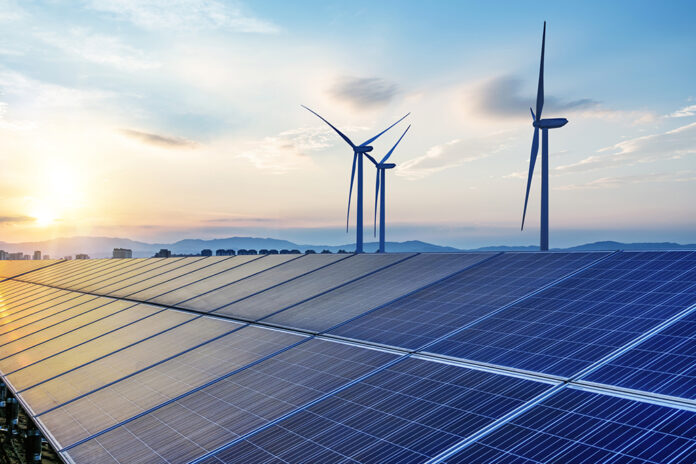Ahead of the COP28 climate summit that has just opened in Dubai, the International Energy Agency (IEA) and the COP28 presidency called for a tripling of renewable energy capacity by 2030 to keep the world on track to limit the rise in global temperatures to 1.5 degrees Celsius above pre-industrial levels.
At present, this looks unachievable.
Annual additions of renewable energy capacity are rising at record rates, with 295 gigawatts added in 2022, but tripling capacity by 2030 requires another 954 gigawatts each year.

To be sure, linear extrapolations have historically underestimated renewable energy expansion, and the expansion could be exponential if investment in electrical transmission and consumption responds sufficiently to the demand for renewable electrification capacity.
However, growth is currently lower than required in each sector except solar PV.
Hydropower
Hydropower remains the largest source of renewable power, but growth is low at just over 2% in both 2021 and 2022.
China’s construction of large hydro projects has underpinned the technology’s expansion. The ability to sustain this declines as the number of remaining suitable sites for large hydropower decreases.
Substantial untapped hydro potential in Africa, South Asia, Central Asia and South America is unlikely to attract the capital required. Moreover, it would take years to complete projects in these places.
Regions already dependent on hydro are not always keen to increase their capacity, owing to dam construction’s local environmental impacts and changing weather patterns adding to output variation.
Wind And Solar Power
Wind and solar will make up the vast majority of capacity additions but have lower capacity factors (the amount of electrical output per megawatt installed), so must be built on a grander scale.
The segment with the highest capacity factor—offshore wind—is the most complex to build and has the least developed supply chains. Recent setbacks in the U.S. offshore wind market demonstrate the difficulties.
Onshore wind follows, then solar PV, which has the lowest capacity factor but is the most straightforward technology to deploy, with the best-developed supply chains.

Solar
According to the International Renewable Energy Agency (IRENA), global solar PV capacity must quintuple by 2030. Wind power must nearly quadruple.
Solar PV capacity must grow fivefold by 2030 and wind power fourfold to meet the ambitions of international organizations.
Solar PV is expanding near-exponentially, reflecting its ‘plug and play’ attributes. Projects can be commercially viable on any scale. Taping into residential and commercial markets provides capital for the technology’s deployment, which is unavailable to any other power generation form.
The IEA expects solar additions of around 440 gigawatts this year, a record but significantly short of the 543 gigawatts needed annually to meet the targets set out by IRENA. Nonetheless, the expansion path suggests solar PV could deliver its share of the overall target or even exceed it.
However, solar PV faces headwinds:
- An expansion on the scale envisaged will require large amounts of land and substantial storage capacity. However, battery facilities raise the need for critical minerals and will dent its environmental credentials as mining expands.
- Vast amounts of obsolete and degraded solar cells will need recycling.
- China’s dominance of solar supply chains could retard deployment if other countries introduce trade barriers to protect domestic solar industries.
Wind
The demands being made on wind are even more ambitious. The Global Wind Energy Council expects over 100 gigawatts of new capacity this year and 680 gigawatts from 2023 to 2027. This compares with an annual requirement of 325 gigawatts under the tripling-by-2030 scenario.
Major Barriers
Renewable energy investment is concentrated in the advanced nations and China. The ambition for 2030 implies a more global effort.

Insufficient international solidarity and financial flows exist between the advanced nations and the Global South, where many countries also lack the expertise and institutional capacities to enact appropriate policies, and poor-quality grids will be incapable of sustaining the electrification required without substantial investment.
In addition, according to the IEA, the tripling of renewable energy capacity needs to be accompanied by doubling the rate of energy intensity improvement.
This depends on much more widespread electrification, particularly in buildings and transportation. It also requires behavioral changes such as greater collective transport use, another area of long-lead-time investment.
The rate of energy intensity improvement has slowed in recent years; doubling it remains an enormous challenge.
A quarter of the emissions savings required by 2050 come from energy efficiency under IRENA’s 1.5-degrees-Celsius scenario.
Meanwhile, developing countries with fossil fuel resources will likely exploit these further to fund their energy transitions and achieve other developmental goals.
Policy Shifts
Substantial policy shifts and the mobilization of trillions of dollars in public and private finance will be required to improve electricity grid infrastructure and system operations, to integrate electricity grids, transport systems and heat and cooling provisions, and to improve energy efficiency.
This will require significantly greater government involvement in shaping the energy transition beyond a supportive policy environment. In the advanced economies, this looks politically less likely.


